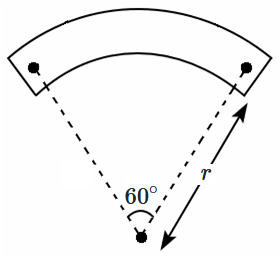An iron rod of susceptibility \(599\) is subjected to a magnetizing field of \(1200~\text{A m}^{-1}.\) The permeability of the material of the rod is:
\((\mu_0 = 4 \pi\times 10^{-7}~\text{T mA}^{-1})\)
1. \(8.0\times 10^{-5}~\text{T mA}^{-1}\)
2. \(2.4\pi\times 10^{-5}~\text{T mA}^{-1}\)
3. \(2.4\pi\times 10^{-7}~\text{T mA}^{-1}\)
4. \(2.4\pi\times 10^{-4}~\text{T mA}^{-1}\)
\((\mu_0 = 4 \pi\times 10^{-7}~\text{T mA}^{-1})\)
1. \(8.0\times 10^{-5}~\text{T mA}^{-1}\)
2. \(2.4\pi\times 10^{-5}~\text{T mA}^{-1}\)
3. \(2.4\pi\times 10^{-7}~\text{T mA}^{-1}\)
4. \(2.4\pi\times 10^{-4}~\text{T mA}^{-1}\)
A bar magnet of length \(l\) and magnetic moment \(p_{m}\) is bent in the form of an arc as shown in the figure below. The new magnetic dipole moment will be:

| 1. | \(p_{m}\) | 2. | \(\dfrac{3}{\pi }p_{m}\) |
| 3. | \(\dfrac{2}{\pi }p_{m}\) | 4. | \(\dfrac{1}{2 }p_{m}\) |
A closely wound solenoid of \(800\) turns and area of cross-section \(2.5 \times10^{-4}~\text{m}^2\) carries a current of \(3.0~\text{A}\). If the solenoid acts like a bar magnet, then what is its associated magnetic moment?
1. \(0.6~\text{J/T}\)
2. \(0.07~\text{J/T}\)
3. \(0.3~\text{J/T}\)
4. \(0.8~\text{J/T}\)
A Rowland ring of mean radius \(15\) cm has \(3500\) turns of wire wound on a ferromagnetic core of relative permeability \(800.\) What is the magnetic field \(B\) in the core for a magnetizing current of \(1.2\) A?
1. \(3.27\) T
2. \(2.56\) T
3. \(1.05\) T
4. \(4.48\) T
Figure shows two small identical magnetic dipoles \(a\) and \(b\) of magnetic moments \(M\) each, placed at a separation \(2d\), with their axes perpendicular to each other. The magnetic field at the point \(P\) midway between the dipoles is:

| 1. | \(\dfrac{2 \mu_{0} M}{4 \pi d^{3}}\) | 2. | \(\dfrac{\mu_{0} M}{4 \pi d^{3}}\) |
| 3. | zero | 4. | \(\dfrac{\sqrt{5}\mu_{0} M}{4\pi d^{3}}\) |
Choose the correct statement regarding magnetism.
| 1. | Paramagnetic sample displays greater magnetization when cooled. |
| 2. | Diamagnetism is almost independent of temperature. |
| 3. | Ferromagnetic substances show hysteresis. |
| 4. | All of these. |
The magnetization of a piece of iron or steel:
| 1. | depends on the strength of the magnetizing field. |
| 2. | depends on external conditions such as temperature. |
| 3. | cannot be done beyond the saturation point. |
| 4. | all of these. |
| 1. | \(9~\text{gauss}\) | 2. | \(4~\text{gauss}\) |
| 3. | \(36~\text{gauss}\) | 4. | \(4.5~\text{gauss}\) |
Magnetic induction at an axial point of a short magnet at a distance \(r\) from the centre of dipole is \(\vec B\). Its value at the equatorial point of the short magnet at the same distance from the centre of dipole is:
| 1. | \(-\vec B\) | 2. | \(\dfrac{\vec B}{2}\) |
| 3. | \(\vec B\) | 4. | \(\dfrac{-\vec B}{2}\) |
The magnetic moment of a magnet \((10 ~\text{cm}\times 4~\text{cm}\times1~\text{cm})\) is \(4 ~\text{Am}^2\). Its intensity of magnetisation is:
1. \(10^{3}~\text{A/m}\)
2. \(10^{2}~\text{A/m}\)
3. \(10^{5}~\text{A/m}\)
4. \(10^{4}~\text{A/m}\)






